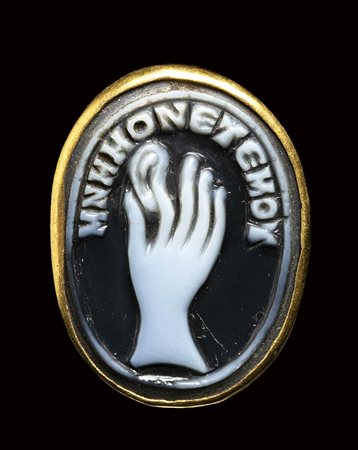 Bertolami Fine Art - Bertolami Fine Art, 1 Harewood Place 1, W1S 1BU Londra
Bertolami Fine Art - Bertolami Fine Art, 1 Harewood Place 1, W1S 1BU Londra
ASTA 107 - Glittica Sessione Unica
venerdì 22 aprile 2022 ore 15:00 (UTC +00:00)
A late roman two-layered onyx cameo set in a gold ring. Hand pinches earlobe with greek inscription.<br><br>3rd - 4th century A.D.
A late roman two-layered onyx cameo set in a gold ring. Hand pinches earlobe with greek inscription.
3rd - 4th century A.D.
On this cameo, a hand pinches an earlobe between the thumb and forefinger; above a greek inscription— ΜΝΗΜΟΝΕΥΕ ΜΟΥ (Μνμονευε μου) meaning « Remember me ».
In Roman art and literature, the ear-tweaking hand is a common motif, meaning a request for attention. Gems such as this were mementos of love, and were probably given as gifts. The motif of the hand pinching or touching the ear as a stimulus to memory, thought to derive from the writings on natural history by Pliny the Elder, is fairly common in Roman gems, and the Greek inscription translates as 'Remember'. Such inscribed gems were popular, and other mottos such as 'Good Luck', 'Unity', or 'Farewell' also exist.
The gold mounting is with rounded hoop extending on high raised oval bezel containing the cameo. Wear marks on the surface of the ring.
Parallels: Louvre museum, inv. Bj 1296; British museum, inv. 1814,0704.1630; Getty museum, inv. 2001.28.11; Hermitage cat. n. 246, 247, 248, 391
Stone 13 x 19 mm; ring size diam. 15,5 mm; 5,30 gr.







